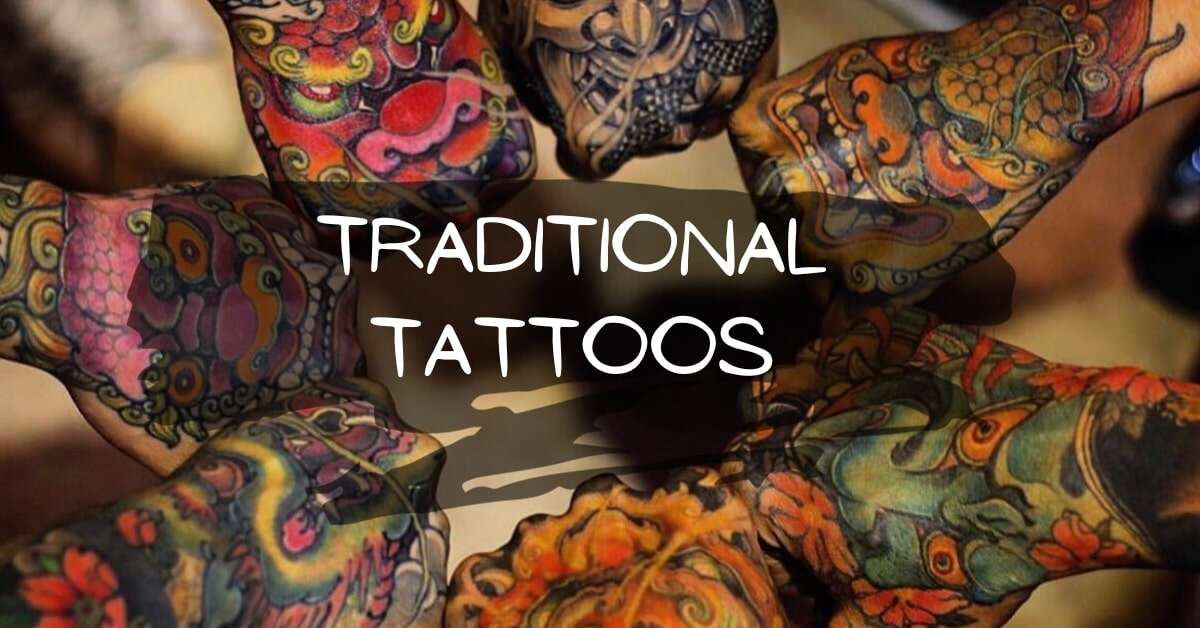Introduction
Traditional tattoos have long held a special place in the world of body art. With their rich history, iconic designs, and enduring appeal, they continue to captivate and inspire. In this comprehensive article, we will take a deep dive into the world of traditional tattoos, exploring their origins, cultural significance, iconic designs, the artistry behind them, the reasons behind their resurgence in popularity, and much more. By the end of this journey, you’ll have a profound appreciation for the beauty and meaning behind these tattoos.
The Historical Roots of Traditional Tattoos
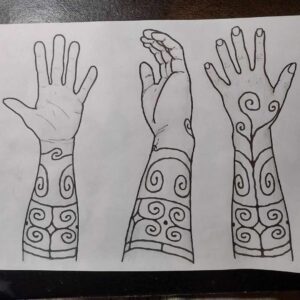
Ancient Beginnings
These tattoos have their roots in ancient cultures around the world, making them a global phenomenon. From the tribal tattoos of Polynesia, which date back over 2,000 years, to the bold designs of American traditional tattoos, these art forms have been practiced for centuries. They offer a fascinating glimpse into the history of human expression through body art.
Roots in Sailor Culture
Traditional tattoos as we know them today emerged out of the sailor culture in the first half of the 1900s. Sailors who embarked on long journeys at sea would get inked at various ports, collecting pieces as they traveled the world. The iconic “anchors away” tattoo was originally an emblem of naval life.
Other classic nautical motifs like ships, roses, daggers, and pins-up represented both the adventures at sea and the loved ones back home. Tattoos symbolized superstitions, milestones, and morals. This tradition of commemorating voyages through tattoos turned into a distinct American tattoo style.
Cultural Significance
It often carries deep cultural meanings that vary from region to region. For instance, in Japan, irezumi tattoos are aesthetically pleasing and symbolize courage and strength. Similarly, the Maori tattoos of New Zealand represent one’s heritage and social status. These cultural ties make it more than just ink on the skin; they are living symbols of cultural heritage.
Iconic Designs in Traditional Tattoos
Classic Motifs
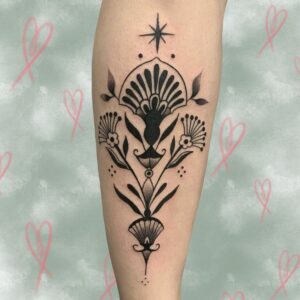
One of the defining features of these tattoos is their use of classic motifs. These timeless designs include anchors, roses, swallows, hearts, and more, each with its own symbolism. For example, an anchor represents stability, while a rose symbolizes love and beauty. Understanding the meanings behind these motifs adds depth and significance to traditional tattoos.
Iconic Imagery
Anchors, ships, roses, daggers, and pin-up girls represented naval life, loved ones back home, superstitions, milestones and morals. This tradition turned into a distinct American tattoo style centered on nautical and wartime symbols.
Bold and Vibrant Colors
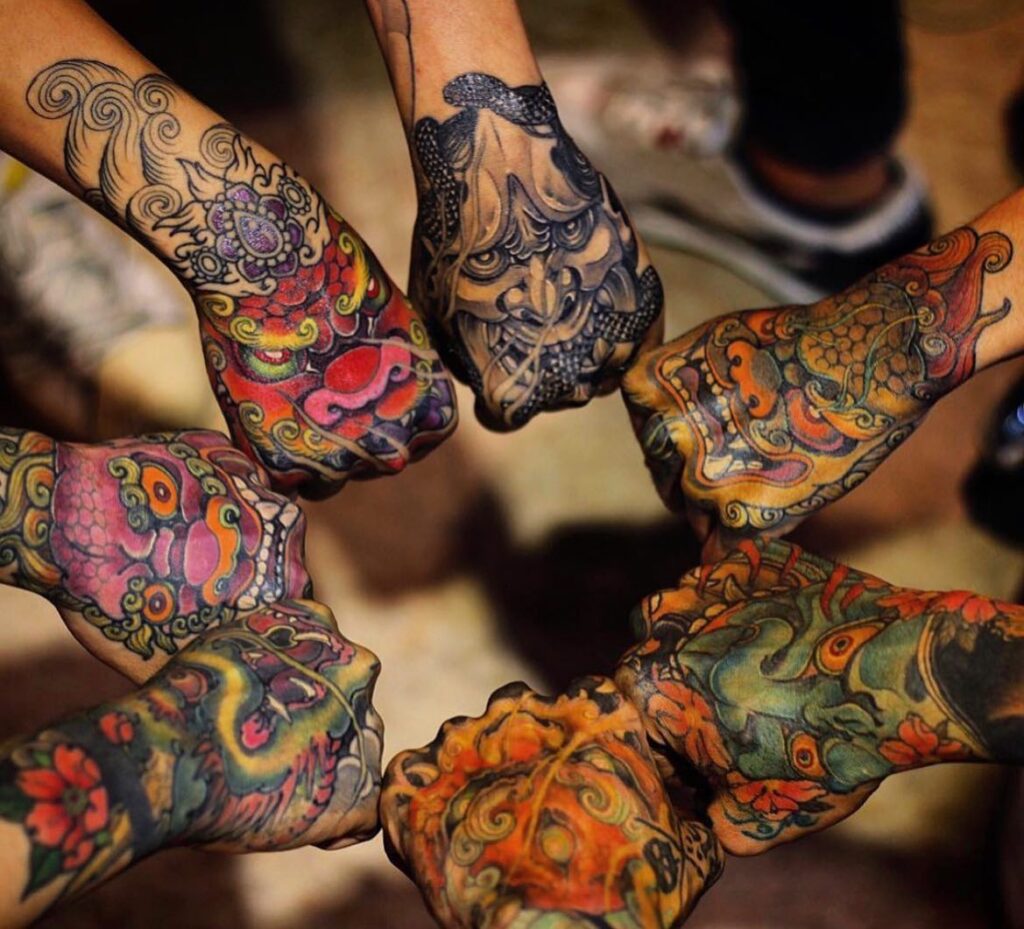
They are known for their bold and vibrant color palettes. The use of bright reds, blues, greens, and yellows not only adds to their visual appeal but also ensures that they stand the test of time. These colors remain vibrant even after years of wear, making traditional tattoos instantly recognizable.
Artistry in Simplicity
The technical artistry lies in the simplicity of traditional tattoos. Instead of photorealistic rendering, traditional tattooers use graphic visual symbols. The style is defined by bold black outlines contrasted by limited bright colors like red, green, yellow, and sometimes purple or brown.
Less is more as artists arrange classic flash designs strategically, weaving together disparate pieces into cohesive body art. The placement intentionally complements the body’s curves rather than masking them. When done skillfully, traditional tattoos amplify rather than overwhelm a person’s natural physique.
A traditional sleeve tattoo
A traditional sleeve tattoo is a collection of various old school styled tattoos that cover an entire arm or leg. Unlike a single unified tattoo design requiring one background, traditional sleeves incorporate deliberate negative space between pieces of different scales from prominent showcase art to smaller filler tattoos. This patchwork quilt concept allows multiple artists to contribute over time rather than needing one tattooer. The artistry is in the strategic arrangement to complement the body’s curves. A cohesive finished traditional sleeve transforms disparate illustrations into a singular body art piece that harkens back to the style’s sailor origins. When done masterfully, it becomes an emblem of visual storytelling passed down through generations.
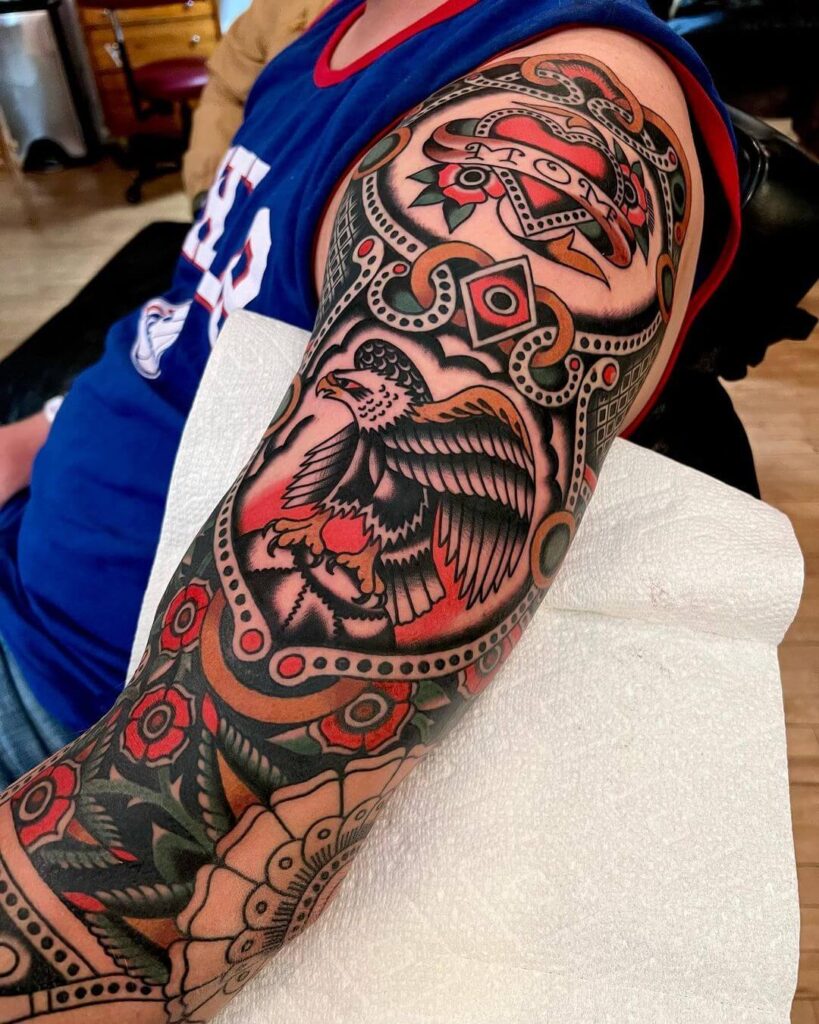
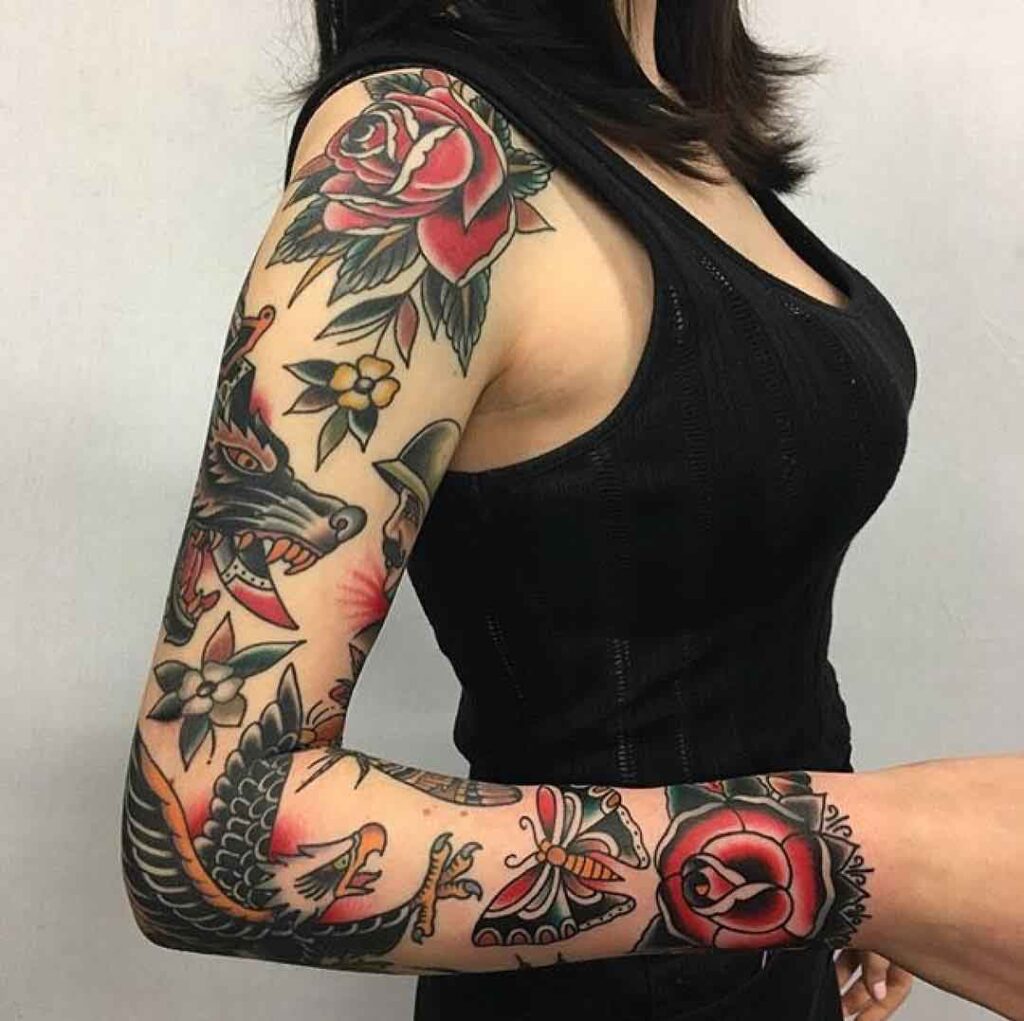
Here are a few key things to know about traditional tattoos:
- Origins – Traditional tattoos emerged out of the American sailor culture in the early 1900s. Images were simple, bold black outlines and designs like ships, anchors, snakes, birds, and pin-up girls. This style is also known as “old school” or “American traditional.”
- Style/Design – Thick black outlines are a hallmark of traditional tattoos. They feature flat 2D imagery in a limited color palette: primarily black, red, green, yellow and sometimes purple and brown. Designs are visually striking with less attention to subtlety or realism. Classic motifs include nautical stars, pinups, hearts, daggers, roses.
- Technique – Traditionally tattoo artists use a technique called “bold will hold,” outlining designs in thick black ink before filling in color. This allows the tattoos to age well over time compared to more delicate tattoo styles. Electric tattoo machines are used to create the quintessential bold lines.
- Artistry – While the imagery is iconography and historically-rooted, the placement and flow of traditional tattoos on the body is an artform. Tattooers arrange standalone motifs or full sleeves with intention, using individual pieces to adorn the body.
- Significance – In addition to their distinct aesthetic, traditional tattoos emblemize the rebelliousness of the counter-culture they emerged from. The style captures a classic, iconic “old school” American tattoo culture that still remains popular today.
The Artistry of Traditional Tattooing
Skilled Tattoo Artists
Creating traditional tattoos requires a high level of skill and precision. Tattoo artists who specialize in this style are known for their expertise in line work, color saturation, and shading. Each tattoo artist is a master of their craft, ensuring that every tattoo is a work of art.
The Tattooing Process
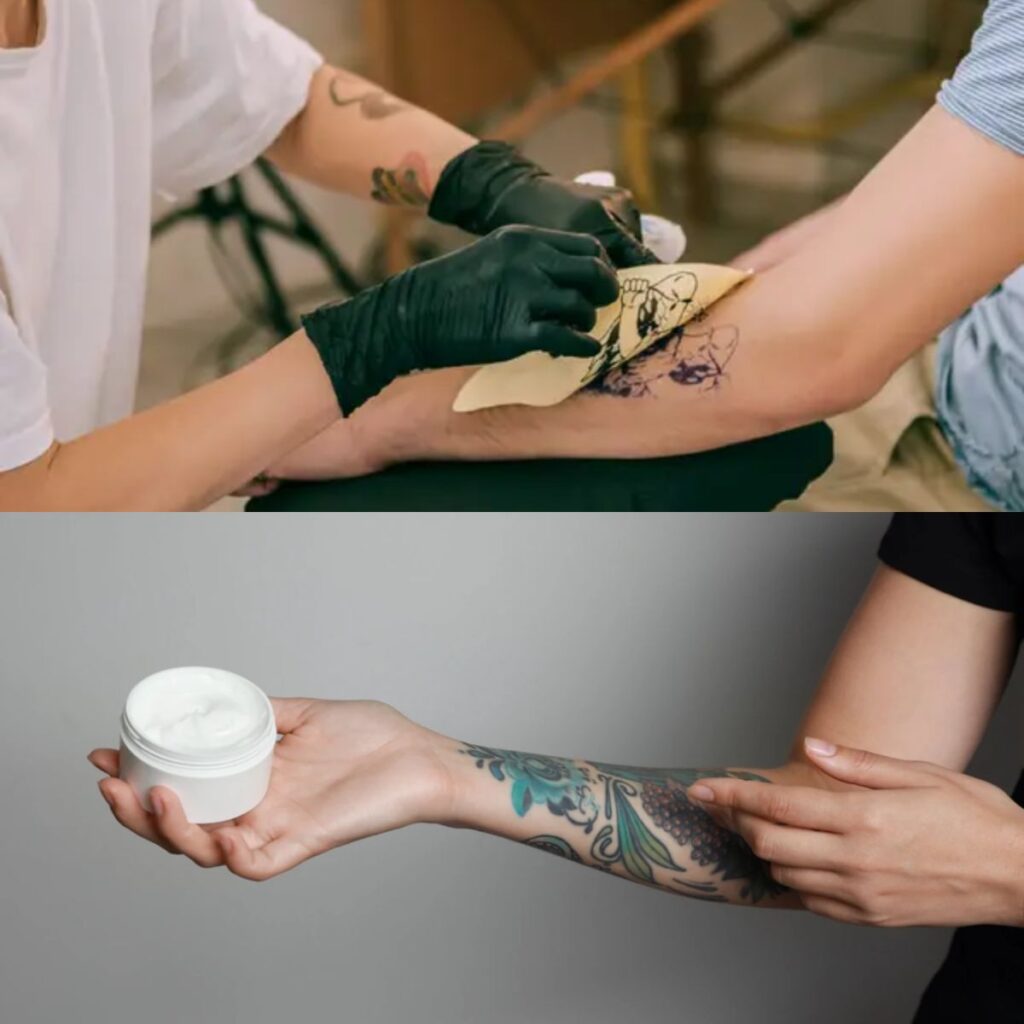
Tattooing itself is a fascinating process. Tattoo artists use machines or traditional hand-poking techniques to insert ink into the skin. This process, while intricate, results in the stunning tattoos that we admire. The attention to detail and precision involved in traditional tattooing sets it apart as a true art form.
The Resurgence
Nostalgia and Connection

In recent years, there has been a resurgence of interest in traditional tattoos. Many individuals are drawn to these designs as a way to connect with the past, honor their heritage, or simply embrace a sense of nostalgia. The resurgence is fueled by a desire for authenticity in an increasingly digital world.
Modern Interpretations
While these tattoos maintain their classic appeal, modern interpretations are also emerging. Tattoo artists creatively blend traditional designs with contemporary elements, resulting in a fusion of old and new. This innovation keeps the tradition alive and relevant in today’s tattoo culture, appealing to both traditionalists and those seeking a fresh take on a timeless art form.
The Versatility of Traditional Inks

Small-Scale Tattoos
They are not limited to large-scale designs. They are equally stunning in smaller forms. Whether it’s a small anchor on the wrist or a tiny rose on the finger, they can be tailored to fit any canvas.
Traditional Inks for All Genders
They are not confined to any specific gender. They are a versatile form of self-expression that anyone can embrace. Traditional designs can be adapted to suit individual tastes and preferences.
The Timelessness of Traditional Inks
Timeless Appeal
While tattoo styles often fade in and out of trend, traditional pieces possess an enduring timelessness, captivating generations with their lasting allure. In an industry where ink styles blow past like seasonal fads, traditional artistry stands resilient, channeling historical symbolism that taps into universal hopes and struggles – love, loss, adventure – distilled into romanticized Naval motifs as relevant today as for WWII sweethearts.
Beyond narratives, the technical execution, with bold outlines and vibrant saturated hues, creates eye-catching designs built to last lifetimes, outliving their owners. When properly etched, traditional tattoos gain character, not lose clarity. Like heirlooms acquiring antique patina, the faded edges tell stories as rich as sailors showing epidermal battle souvenirs. While society accelerates dizzyingly fast, these tattoos connect us to humanity’s past, preserving memories beyond flesh’s expiry, their very medium designed for permanence. Unlike trends, history endures shifts in style – just like the classic ink embedded in skin keepers of lore long after fads fade.
Conclusion
In conclusion, traditional tattoos are more than body art; they are a testament to the enduring power of culture, creativity, and self-expression. From their historical roots and iconic designs to the skilled artists who bring them to life, these tattoos continue to leave a lasting impression. Their resurgence in popularity speaks to their timeless charm, and their versatility ensures that they remain a relevant and captivating art form.
FAQs
Are traditional tattoos only black ink?
No, traditional tattoos can incorporate a wide range of colors, but they are known for their bold and vibrant color palettes.
What is the significance of a swallow in traditional tattoos?
A swallow traditionally symbolizes a safe return home and is often associated with sailors.
Do traditional tattoos hurt more than other tattoo styles?
The pain level of a tattoo can vary from person to person, but traditional tattoos are not inherently more painful than other styles.
How long does it take to get a traditional tattoo?
The time required for a traditional tattoo depends on its size and complexity. Small tattoos may take an hour or less, while larger pieces can take multiple sessions.
Can I get a traditional tattoo even if I’m not from the culture it represents?
Yes, traditional tattoos are a form of artistic expression, and you can choose a design that resonates with you personally, regardless of your cultural background.
For a deeper understanding of tattoos and to explore contemporary interpretations, Save https://maestrotattoo.com and read our blog. Access a world of ink and discover the stories behind each tattoo, where tradition meets innovation.
